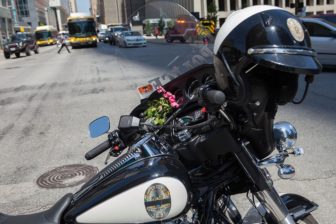The day after Dallas became the scene of the single greatest loss of police officer lives since September 11 brought a fragile peace.

Leslie Boorhem-Stephenson / The Texas Tribune
Flowers sit on the dash of a Dallas Area Rapid Transit police motorcycle as it is used to block off the scene where, the night before, snipers targeted police officers, killing five, after a peaceful Black Lives Matter protest in downtown.
Protesters, who had gathered Thursday evening at one of multiple rallies against police aggression nationwide, spoke of the support they received from a city police force that has made strides toward repairing its relationship with the black community. At a news briefing Friday, Dallas Police Chief David Brown demanded the end of “this divisiveness between our police and our citizens.” Gov. Greg Abbott, a Republican, asked Texans to come together, warning of those “who foment distrust and fan the flames of dissension.”
But amid the calls for unity, tension simmered, threatening to reopen ugly wounds that the nation’s ninth-largest city has tried to heal in recent years.
In seeming conflict with Abbott’s message, several other Texas Republicans, including Lt. Gov. Dan Patrick, blamed the Black Lives Matter movement, a loosely organized group of activists that pushes for higher scrutiny of the use of force by police, for encouraging the attack.
“All those protesters last night, they ran the other way, expecting the men and women in blue to turn around and protect them,” Patrick said. “What hypocrites!”
The attack, which occurred in downtown Dallas just blocks from where John F. Kennedy was assassinated, left at least five police officers dead and six more injured.
At a media briefing Friday, Brown said the alleged sniper told police shortly before he was killed by a police-detonated explosive that he was upset about the recent police shootings.
“The suspect said he was upset at white people. The suspect stated he wanted to kill white people, especially white officers,” Brown said.
The Dallas attack was the third in a series of high-profile events in an emotionally charged week, after police officers killed black men in Baton Rouge, Louisiana, and Falcon Heights, Minnesota.
It comes almost exactly a year after the arrest of Sandra Bland, a black woman whose death in a Southeast Texas jail propelled a national conversation about race and policing. Pulled over for failing to signal a lane change, Bland was arrested for assaulting a public servant after arguing with the police officer. Her death, which came after three days in her cell, was ruled a suicide.
Black leaders expressed fear that the Thursday shooting would only further propel racial violence and distract from the larger issue of institutional police brutality.
It plays to the “worst,” most “nativist” attitudes Americans have, said Kevin Cokley, a professor and director of The Institute for Urban Policy Research and Analysis at the University of Texas at Austin.
“This is what happens when people are hurting and when they feel like they’re not being heard,” he said. “And then you have these heinous, unfortunate, tragic incidents that we’ve had this week for both police officers and black folks.”
The city has long made efforts to mend the rift between law enforcement and its black community. The 1986 death of Etta Collins, a 70-year old black woman who had called 911 because of a burglary next door, at the hands of a Dallas policeman fueled a push for stronger oversight of the department.
Over the next two decades, attempts at reform continued, particularly after a series of officer-involved shootings in 2012 and 2013. Since becoming police chief in 2010, Brown has implemented a highly restrictive deadly force policy and officer training heavily focused on de-escalation tactics. In that time, the number of excessive-force complaints against Dallas officers has steadily decreased.
There has been a marked improvement in the relationship between the Dallas police force and the black community, said Naomi Baxter, a member of Mothers Against Police Brutality, who attended the rally Thursday.
Baxter joined the organization to protest police brutality after her cousin, Clinton Allen, was shot and killed by a police officer in 2013.
“Chief Brown has really taken it upon himself to talk with the police officers, to let them know they’re here for the people, and I feel like they are,” she said.
Dallas officials have worked hard to improve what has historically been “a very troubled relationship” with the community, said former police chief Bill Rathburn.
“I think that started changing significantly while I was there and I think the pattern has continued up until the present day,” said Rathburn, who led the department from 1991 to 1993. “I think people have to be careful not to judge the city or the police department or the officers based on the actions of one individual, one deranged individual. I think it was an incident that reflects the individual responsible for it or the individuals responsible for it, rather than an indication of some serious underlying problem between the police department and the community that it serves.”
It is time, Rathburn said, for politicians and community leaders to come together to have a constructive conversation about race and policing.
Bee Moorehead, the executive director of Texas Impact, an interfaith advocacy group, echoed his comments.
She said that it was not just conservatives — but liberals as well — who were reluctant to talk with others with different racial or religious backgrounds.
“Now we’re in a position where we are completely overwhelmed. Now we’re really scared. Now we really need to figure out what to do, because for so long we couldn’t stand to have conversations that were a little bit hard,” she said. “There is no one with clean hands.”
Madlin Mekelburg, Jordan Rudner and Terri Langford contributed reporting to this story.